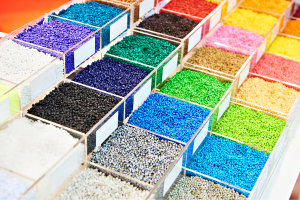Despite the fact that plastic was developed more than 170 years ago, the material still finds new applications. Plastics are used both in households and in business. What is worth knowing about plastics: their types, properties and applications? Become familiar with a brief summary.

What are plastics?
Before we focus on the types of plastics and their applications, let’s find out what they actually are. The term “plastic” refers to a wide group of materials manufactured using industrial methods. The materials are made of polymers, i.e. chemical compounds, most often consisting of organic molecules. Due to their composition, plastics are otherwise known as polymer materials. Some, for simplicity’s sake, refer to plastics simply as plastic. However, it is worth knowing that there are many different types of plastics of different purpose and a defining name.
Plastic functions both as the main component and as an additive co-forming many objects or materials for everyday use. Each polymer material has a wide range of applications that are closely related to its properties. What makes plastics different and where are they used?
Plastics and their properties
Their unique features play a key role in the production of plastics. What properties do plastics have? Of particular importance is their mechanical resistance and the possibility of easy processing, giving a specific shape or structure. Most plastics are fully or partially resistant to corrosion and water. Moreover, this material is very durable, very light and can be dyed in various shades.
The plastics are also characterised by high thermal and electrical insulating power. Most of plastic materials are recyclable.
Find out which plastics are recyclable.
Properties of plastics and their application
There is no doubt that one of the most important properties of plastics is corrosion resistance. It makes plastic ideal for the production of packaging materials, bottles or building and insulation materials. Bags, disposable dishes, insulating tapes, protective films and many other daily-use products are made from plastic.
Another very important feature of plastics is their plasticity. This property warranted their recognition of, among others, manufacturers in the packaging, plumbing, clothing, food, pharmaceutical, construction and many other industries.
The wide range of types and properties of plastics makes them more and more popular in global production and is responsible for the growing demand for plastic. This raw material is cheap and easy to process – so it works well as a substitute for metal, wood and paper, the production of which generates significant losses of energy, water, etc.
Types of plastics and their properties: duroplasts, thermoplasts and elastomers
All plastics react to high temperatures in a certain way. When exposed to heat, some types of plastic shrink and deteriorate faster than others. Other types easily tolerate even very high temperatures and change their state of matter. Due to the reaction to heat, polymer materials are classified into three groups:
DUROPLASTS
are high-quality, non-melting thermosetting materials that harden under thermal treatment or due to the action of a suitable hardener. Examples of duroplasts include: synthetic resins and polyacrylonitrile polymers. Duroplasts are used by laminate manufacturers and chemical, electrical, automotive, interior design and injection mould companies.
THERMOPLASTS
(otherwise known as thermoplastics) are materials that change shape and become malleable under the influence of increasing temperature. Unlike duroplasts, thermoplasts can be reshaped many times and retain their shape when cooled. Examples of thermoplasts are: polyethylene and polystyrene. Thermoplastics are used e.g. in the production of packaging, films, toys, footwear or insulation materials.
ELASTOMERS
are synthetic organic materials with the ability to stretch and return to their original form. The category of elastomers includes both synthetic and natural rubber, as well as other materials: polyurethane elastomers and silicones. The material is used on a large scale by manufacturers in the construction and finishing, medical, electrotechnical and automotive industries.

Classification and use of plastics
These days, there are many applications of plastics and we are still discovering new ways to use them in everyday life. Therefore, there is no single classification of polymer plastic applications. They can be divided into different groups, including:
- food-grade plastics e.g.: polypropylene (PP), HDPE (high-density polyethylene), LDPE (low-density polyethylene), PS (polystyrene) and PET (polyethylene terephthalate);
- plastics used in the production of cosmetics and chemicals: poly(ethylene oxide) – PEG, sodium polyacrylate;
- technical and construction materials, e.g.: polyvinyl chloride (PVC), polyamide (PA), polycarbonate (PC);
- materials used for the production of clothing, such as: polyester (PES), acrylic (AC).
Recycled plastics: production and use
A separate group of plastics having various applications in industry and everyday life, are recycled materials. These are usually bottles, packaging or films made of LDPE, HDPE, PP or PET. Selectively collected, plastic waste goes to special plants where it is recycled. Semi-finished products (e.g. granules) are made from used plastics. Later, these are used to produce:
- films, tapes, packaging and non-woven fabrics (used in construction, courier services, agriculture, food industry, etc.),
- toys, home accessories, sports equipment,
- clothing and footwear,
- water and sewage pipes, wiring elements,
- disposable dishes, containers, trays, etc.
More and more often, the global manufacturers of electronics, household appliances and furniture are also looking for new possibilities of using recycled plastics. This material is also becoming interesting for designers of modern ecological construction, a field that is currently experiencing its greatest boom.
- Duroplasty, hasło w: Encyklopedia PWN (dostęp: https://encyklopedia.pwn.pl/haslo/duroplasty;3895051.html),
- Elastomery, hasło w: Encyklopedia PWN (dostęp: https://encyklopedia.pwn.pl/haslo/elastomery;3897233.html);
- Termoplasty, hasło w: Encyklopedia PWN (dostęp: https://encyklopedia.pwn.pl/haslo/termoplasty;3986733.html).
- https://www.researchgate.net/profile/Malek-Hassanpour/publication/326894136_Plastics_Applications_Materials_Processing_and_Techniques/links/5b6abc6d45851546c9f6c001/Plastics-Applications-Materials-Processing-and-Techniques.pdf
